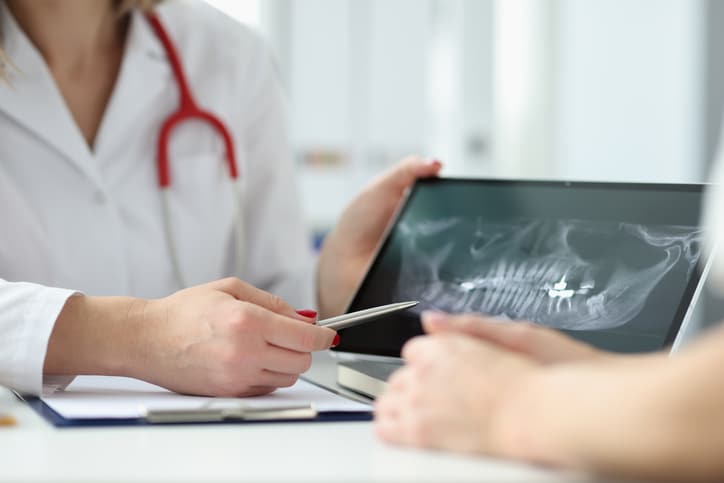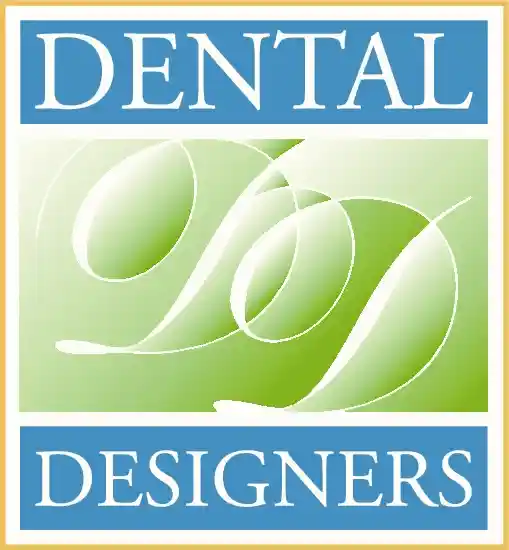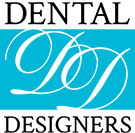Are Dental X-Rays Safe at My Rockford Dentist?

Introduction
Dental X-rays are an essential diagnostic tool most patients encounter during routine dental exams. While X-rays provide valuable information about your oral health to your Rockford dentist, some patients express concerns about the safety and radiation exposure of these imaging tests. This article will overview how dental X-rays work, their benefits, risks, safety best practices, and the latest research on their safe use. With an understanding of the facts, you can feel confident that dental X-rays are safe when used correctly.
One of the latest updates in the dental X-ray sphere is that thyroid collars or shields are no longer recommended for any imaging procedures in dentistry. But of course, some patients still stay skeptical and prefer to use the collars.
How Do Dental X-Rays Work?
Dental X-rays use small, controlled doses of radiation to create images of the teeth, jaws, gums, and other areas.
The X-Ray Tube
At the heart of the dental X-ray machine is the X-ray tube. It generates and aims a beam of X-ray radiation at the examined area. The tube has a filament that is heated to emit electrons, along with a target made of tungsten or other metal. When the accelerated electrons strike the metal target, x-ray photons are produced. The beam emerges from a small window aimed at the tooth.
Producing the Image
As the X-ray beam passes through the tooth and surrounding areas, denser tissues like bone absorb more radiation while soft tissues absorb less. This difference shows up in the final image. Traditional film X-rays use photographic film that is more or less exposed based on the absorbed radiation. Digital photos use electronic sensors that measure the X-ray exposure to create the image pixel by pixel.
Focusing the Beam
A narrow beam aims precisely at the area of interest to keep radiation exposure in the surrounding regions low. Metal cones around the tube focus and aim the beam. A positioning device holds the film or sensor while the tube is angled to get the desired view.
Recording Details
The resulting radiographs show differences in tissue density as lighter or darker. This contrast allows the dentist to see decay, infections, gaps, and other issues that require treatment. Modern digital sensors and film provide excellent detail for diagnosing dental problems.
Technological improvements in dental X-ray equipment:
- Digital imaging sensors are now commonly used instead of traditional photographic film. The sensors convert X-rays into digital signals, allowing for post-processing to optimize image quality. This allows clear images to be produced at lower radiation levels.
- Modern dental X-ray tubes have focal spot sizes as small as 0.4 mm. Smaller focal spots produce sharper images and allow radiation to be collimated into tighter, directional beams aimed only at the region of interest. This reduces scatter radiation.
- Tube voltage, current, and exposure times can be precisely controlled digitally. This allows the radiation dosage to be customized to the imaging requirements of each patient. Lower doses are feasible without sacrificing diagnostic quality.
- Image processing software can further enhance images by adjusting brightness, contrast, and sharpness. Software algorithms can clean up noisy images produced at low exposures.
- Sensors and software can also compensate for differences in tissue density, which helps in visualizing both hard and soft tissues clearly.
- Lead lining around the tube collimates the X-ray beam even further and filters out secondary/scattered rays.
Modern dental X-ray technology combines optimized digital image capture, directional beam alignment, and post-processing software to achieve high-quality images using the minimum radiation necessary. This improves the risk-benefit profile for patients.
Lead aprons and thyroid shields:
- Previously, the X-ray beams from older dental equipment tended to be less directional, leading to more scattered radiation exposure.
- Lead aprons and thyroid collars help block scattered rays by attenuating the radiation before it reaches radiation-sensitive tissues like the torso and thyroid gland.
- However, modern dental X-ray units produce very little scattered radiation due to the tighter collimation of the beam. Most of the radiation is now concentrated in the direct beam aimed at the jaw/teeth.
- Studies have shown that for digital dental radiography systems, radiation exposure to the patient’s torso and neck areas is less than 1% of the dose to the directly irradiated oral tissues.
- At such low levels of exposure, the risks of biological effects from scattered radiation are considered negligible compared to natural background radiation levels.
- Therefore, the minor protective benefit offered by lead shields is outweighed by the inconvenience and costs associated with using them routinely.
- However, lead shields may still be warranted for certain higher-risk scenarios, like if extensive sets of dental films are needed or for radiation-sensitive populations. But this should be evaluated on a case-by-case basis.
Lead aprons and thyroid shields offer diminishing protectiveness against scattered radiation from modern, tightly collimated dental X-ray equipment and are no longer considered necessary for routine use.
Risks and Safety Concerns of Dental X-Rays
While dental X-rays involve very low radiation doses, some risks and safety considerations remain. The ADA recently released new guidance in JADA. Thyroid collars or shields are not required anymore for dental imaging.
Radiation Exposure
While dental X-rays require some degree of radiation, the potential risks are low when proper safeguards are followed.
- Ionizing Radiation: X-rays are an ionizing radiation that can potentially damage cells and DNA. However, the beam is precisely targeted, and the doses needed for dental imaging are tiny.
- Cumulative Effects: There are cumulative effects from radiation exposure over a lifetime. Multiple dental X-rays or repeat images do contribute to overall exposure. However, modern limits make the doses from individual scans extremely low.
- Perspective on Exposure Levels: The radiation exposure from a dental X-ray is well below everyday environmental radiation and on par with taking a short airplane flight. It is also far less than more extensive medical imaging tests like CT scans or PET scans when full-body radiation is used.
- Adhering to ALARA Principles: Dentists follow the ALARA approach to keep radiation “As Low As Reasonably Achievable.” Digital sensors, tight collimation, and proper shielding all limit exposure. Based on up-to-date research, consultants help set imaging techniques and dosages to adequate minimum levels.
- Weighing the Benefits: Potential risks to cells and DNA from radiation must be weighed against the benefits of diagnosing dental disease early when treatment is more straightforward and outcomes are better. Used properly, the benefits justify the low radiation risks for most patients.
Frequency of X-Rays
While dental X-rays are beneficial, getting them too frequently does increase total lifetime radiation exposure. However, with modern safeguards, the risks are low when following clinical recommendations.
Importance of Intervals: Frequency is the primary factor dentists control to balance diagnostic benefits against cumulative radiation exposure. Research helps determine ideal intervals between X-rays for different age groups and conditions.
Bitewing Frequency: The ADA recommends bitewing x-rays at 6-12 month intervals for patients with higher decay risk and 12-24 months for patients with lower risk. More frequent bitewings provide little added diagnostic benefit and are not recommended.
Panoramic Frequency: Panoramic X-rays are indicated at longer intervals every 3-5 years in most patients since they show overall jaw anatomy rather than finer details between teeth. More frequent panoramic X-rays are seldom beneficial.
Case-by-Case Evaluation: Some clinical situations, like monitoring orthodontic treatment, may require more frequent X-rays. However, dentists evaluate the need individually in each case and strictly limit frequency to essential diagnostic requirements.
Patient Communication: Dentists should explain why they want to take x-rays more frequently than usual. Write down the sentence below more understandably and naturally. At the same time, patients have to feel informed enough to inquire about the reasons for radiation exposure if they are worried about that.
American Academy of Oral and Maxillofacial Radiology is considered an authoritative source:
- It is the AAOMR, which is the main representative body of the oral and maxillofacial radiology profession in the U.S.
- These people are scientific imaging and interpretation radiologists for dental applications. They have proficient knowledge of dental radiography technology and radiation control.
- The academy creates education curriculums, new guidelines, and new safety standards for the dental radiology profession.
- In the process, it works hand in hand with agencies such as the FDA and EPA in matters related to radiation from dental X-rays and equipment.
- The AAOMR has continued to keep track of the most recent imaging in dental research and the assessment of risks.
- Progressive radiation protection policies and recommendations made by its members are based on continuous analysis of the current evidence and clear direction from experts.
- As the leading professional organization in this specialty field, the policies and protocols adopted by AAOMR represent the predominantly accepted guidelines for all dental practices in the nation.
- This implies that the AAOMR has taken the lead in stating that aprons are no longer necessary for routine dental X-rays. As such, it offers sound scientific evidence to change long-standing radiation safety practices.
The number of experts, the active engagement in reviewing the research process, and the major role in designing dental radiography protocols are the elements that make the AAOMR an authoritative voice in determining radiation safety, like a lead apron, rules, etc.
Improved dental X-ray safety:
- It may cause higher cumulative radiation doses in patients who need deeper dental X-ray imaging, such as full mouth series, CT scans, and repeated films now and then over a short period. In these situations, the use of lead shielding could guarantee an even higher level of protection.
- These groups may not need the common collars and aprons in areas with radiation exposure, but the thyroid collars or aprons can be used in these cases.
- Based on the number of films, the individual sensitivities to radiation, and the comfort of the lead shields, dentists should evaluate the cases in which their usage is necessary or not.
- The safety advantage of dental X-rays is comforting news for nervous patients who had concerns about radiation exposure before. This could lead to an increase in compliance with the said dental films.
- When a patient understands that the risk of radiation in X-rays is minimal, he may accept those procedures that are able to detect issues like cavities, gum disease, and oral cancer in the early stages when they can be treated much more easily.
- Bitewing X-rays should be taken annually or biannually as a way to monitor any problems that might arise between a regular cleaning or exam, which are preventive tools. The lower risk of radiation makes them justifiable even on routine use.
- In sum, the modernization of dental X-ray devices gives dentists a chance to use that important diagnostic imaging modality more and more for everyday dental care with minor harm to patients.
The Latest Research on Dental X-ray safety
- Extensive research evidence demonstrates that lead aprons and thyroid collars do not meaningfully reduce radiation exposure to the torso and neck during dental X-rays.
- The radiation scatter within the body that could reach the thyroid or torso is negligible with modern tightly collimated dental X-ray beams. So, external shields provide little added protection.
- Lead shields can actually interfere with getting a clear image of the teeth/jaw if they obstruct the primary X-ray beam. This could necessitate retakes and higher overall radiation exposure.
- Ensuring high-quality diagnostic images with the minimum necessary radiation is the priority for patient protection. Lead shields provide no clinical benefit and can work against this goal.
- Most states still need to update their regulations to align with current evidence and remove the requirement for lead shields in dental imaging.
- As policies change, dentists should clearly explain the rationale to patients and reassure them through education on the safety data.
- For some patients, the lead apron provides psychological comfort and a sense of protection. This perspective should be acknowledged despite the lack of scientific evidence.
The expert opinions emphasize that dental radiation safety should focus on minimum necessary exposure, quality images, and patient education rather than on unsupported use of lead shields. Policy changes are still needed in many states to enable evidence-based practice.
Patient psychology and specific concerns:
- There is substantial research evidence that lead aprons and thyroid collars are not that effective due to the fact they do not significantly protect the torso and neck from radiation during dental X-rays.
- Modern tight collimation dental X-ray beams produce scattered radiation within the body that would not reach the thyroid and torso, which are negligible. In other words, superficial protections are of little use.
- The same issue can affect the clear view of the teeth and the jaw due to the use of lead shutters. It may require repeated doses at a higher overall effective dose.
- The patient’s safety should be a major concern. Therefore, radiological images of the maximum possible quality need to be obtained with the minimum dose of radiation. Protective shields or foreign bodies provide, at most, no clinical benefit and can even be counterproductive to this goal.
- Practitioners should weigh the evidence-based practice with sensitive communication to overcome the patient’s fears. The emphasis should be on providing education on safety as a reassurance measure.
- Some groups, like pregnant women, could benefit from both knowledge of the small risks and the availability of lead shields in case they wish. An occasion approach looks rational.
- The critical point is how to offer the right amount of exposure to radiation from dental X-rays and still have the necessary diagnostic results for the respective patient.
Education of patients, reassurance of their concerns, and psychological aspects are all important to address once there is a change in radiation practices that are long-standing and viewed by patients as protective.
American Dental Association Guidelines
The ADA’s safety recommendations represent best practices for minimizing dental X-ray radiation exposure:
- ALARA Principle: Dental radiographs should be taken with as low exposure as possible according to the ADA guidelines. The minimum radiation should be used to get adequate image quality, too.
- Collimation and Shielding: Proper implant position and collimation to block stray radiation is critical. The necessary use of lead shielding is always applicable.
- Dosage Levels: Recommended exposure dosages are based on up-to-date research into the types of x-rays and patient sizes. The digital sensors permit a lower dose.
- Image Quality: However, for accurate diagnosis, the image resolution should be sufficient, but the unnecessary increase of radiation for the images that are too sharp should be eliminated.
- Safety Culture: Radiation Safety procedures and Quality Assurance programs should be enforced by all offices to increase compliance.
- Guideline Awareness: Dentists and dental hygienists need to stay current on the safety guidelines by relearning new techniques and skills.
- Patient Informed Consent: Patients must be aware of radiation risks and agree to X-rays except in emergencies involving life-threatening medical conditions that warrant immediate imaging procedures.
By adhering to the ADA principles, dental practices utilize X-rays with caution to acquire the most beneficial diagnostic outcomes with the minimum dose of radiation exposure for patients.
Conclusion
Dental X-rays utilize radiation; however, the latest technology and safety precautions reduce radiation exposure. The health benefits of identifying the diseases at the early stage are much more than the risk from radiation, which is minuscule. Apply the recommendations of your local dentist, especially the safety measures, and thus enjoy the perks of X-rays, knowing their risks are minimal. Speak to the dentist about x-ray safety precautions or any other questions or concerns you may have if you are in Rockford.
Schedule Your Appointment if you have a question or need a consultation.

